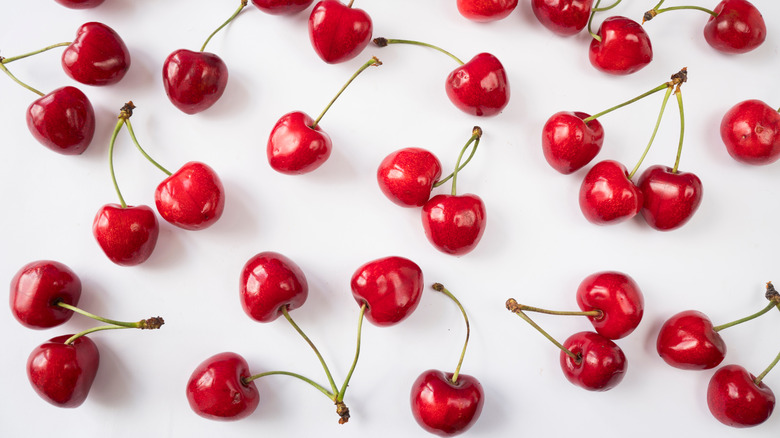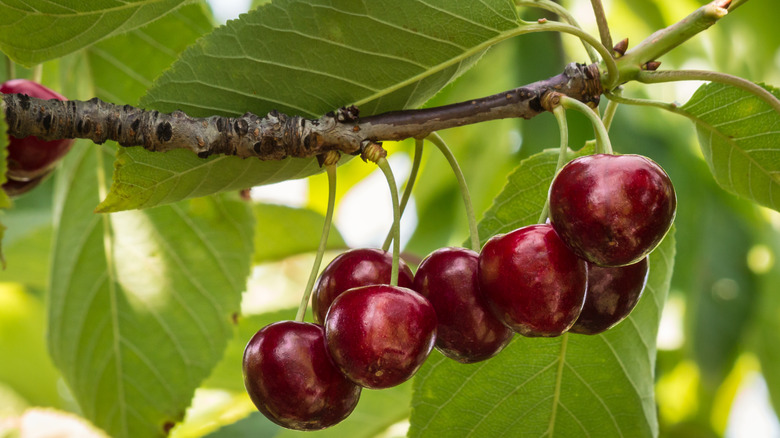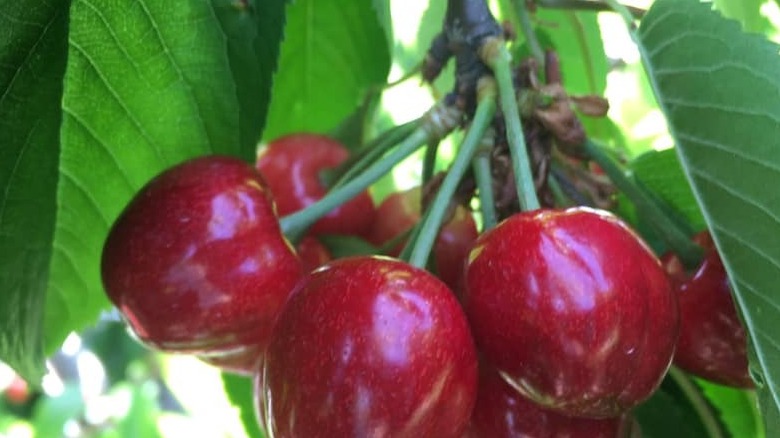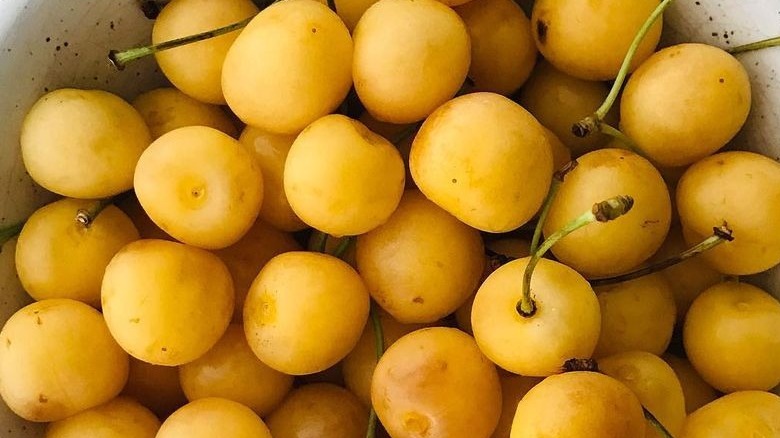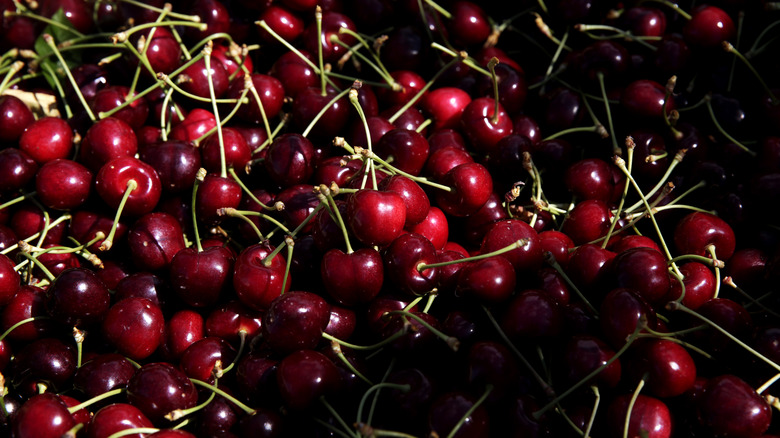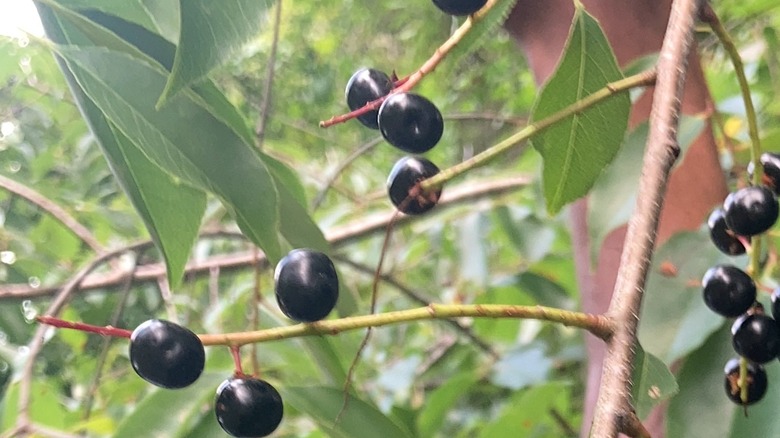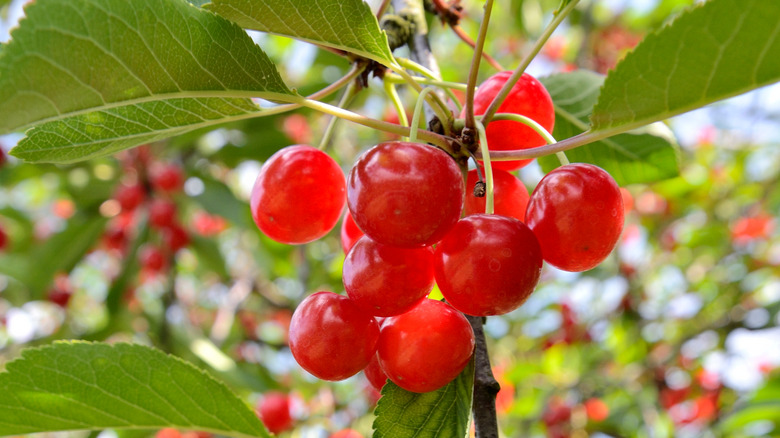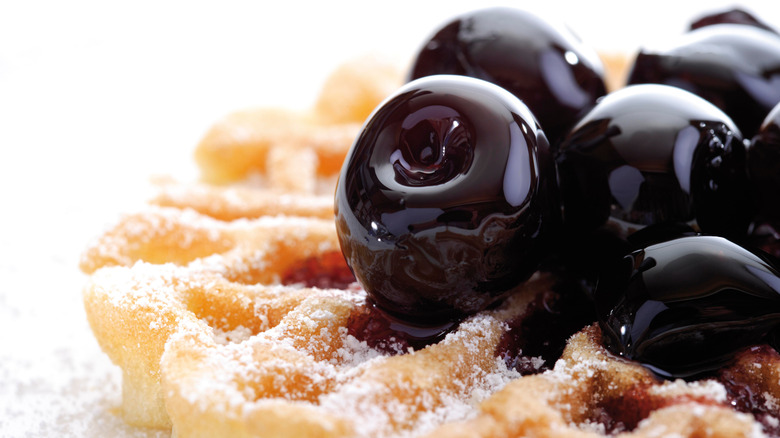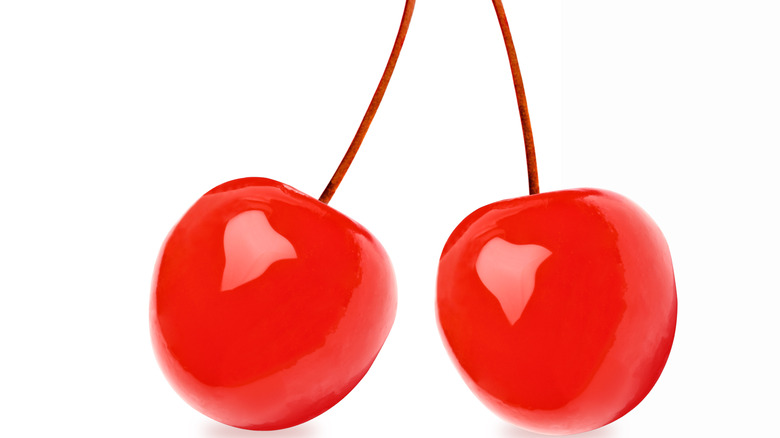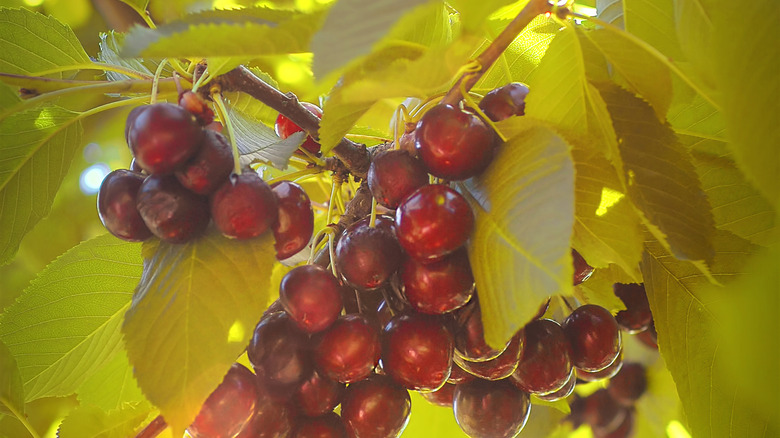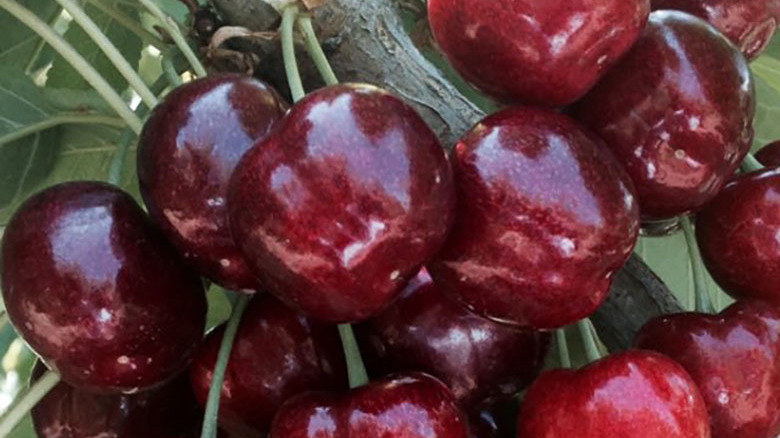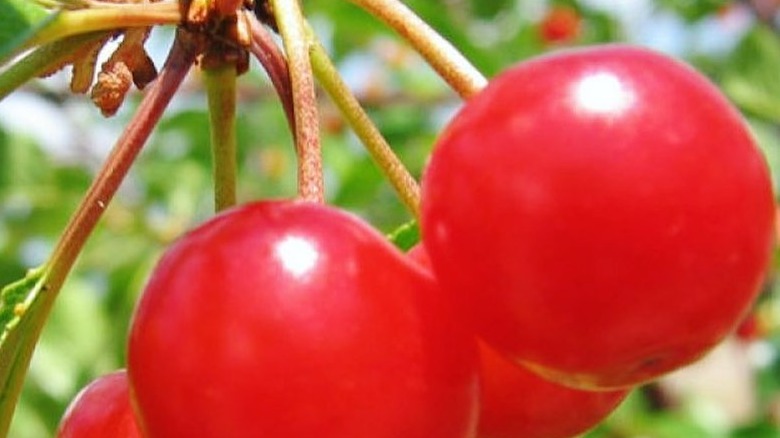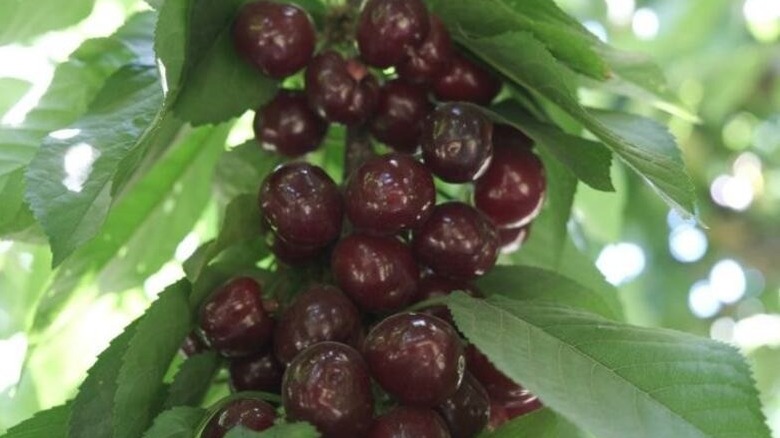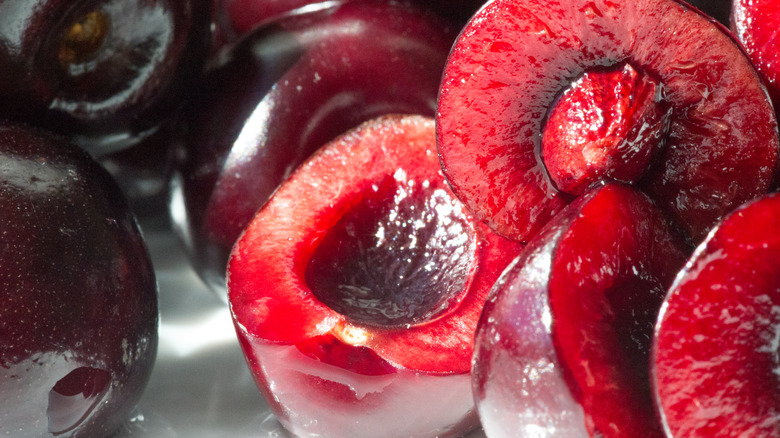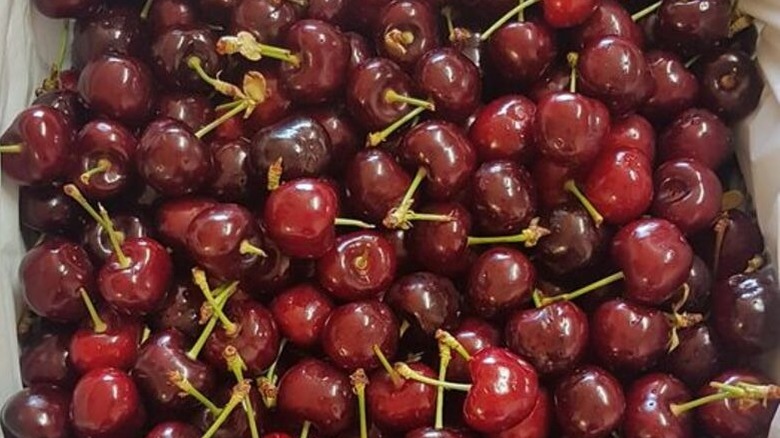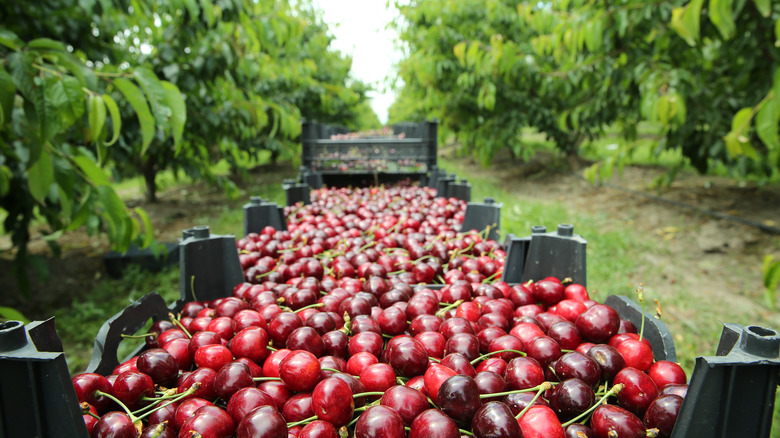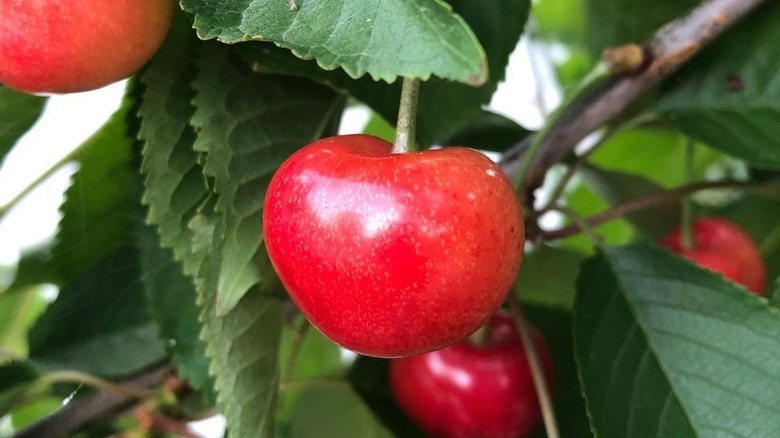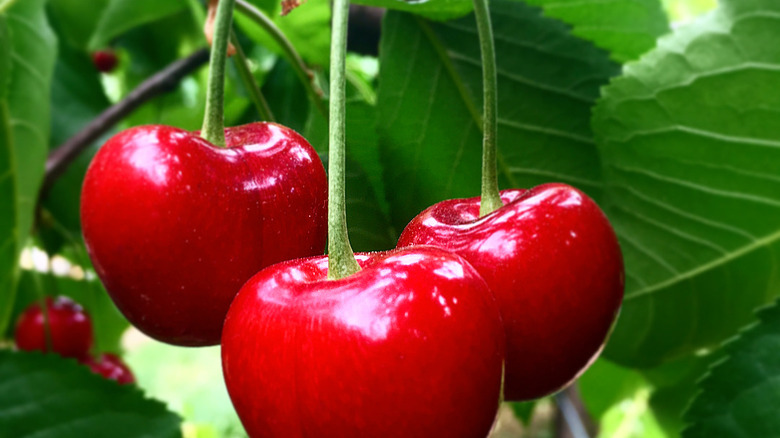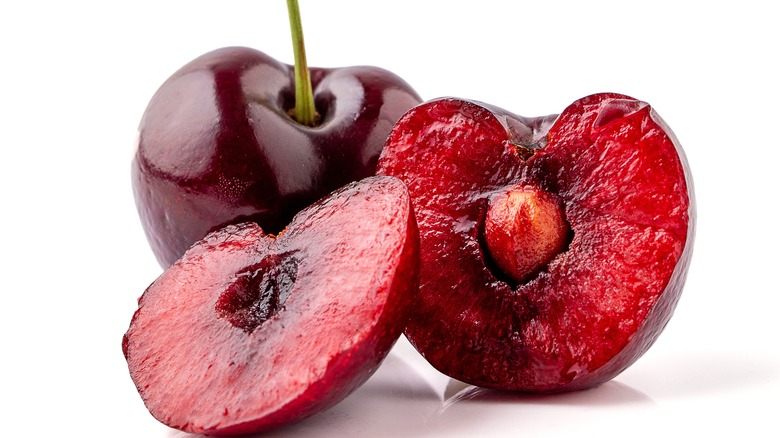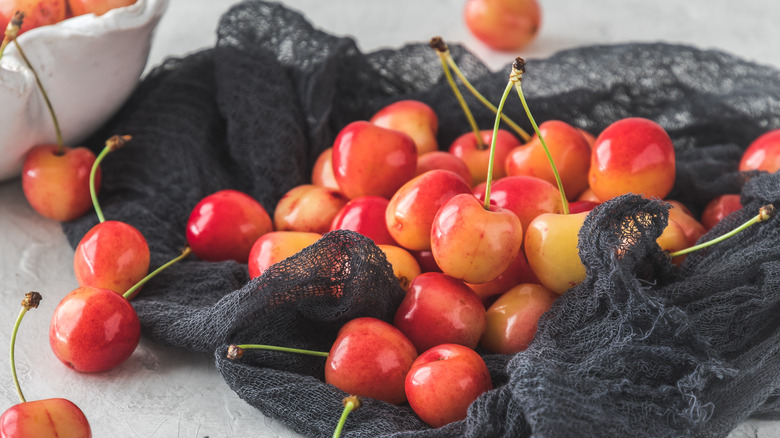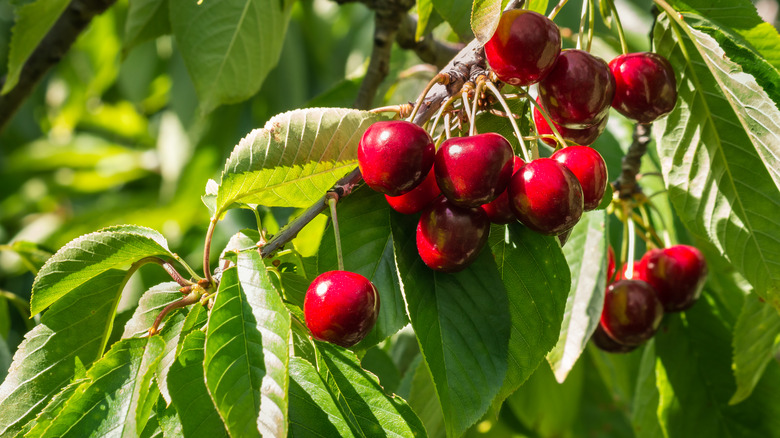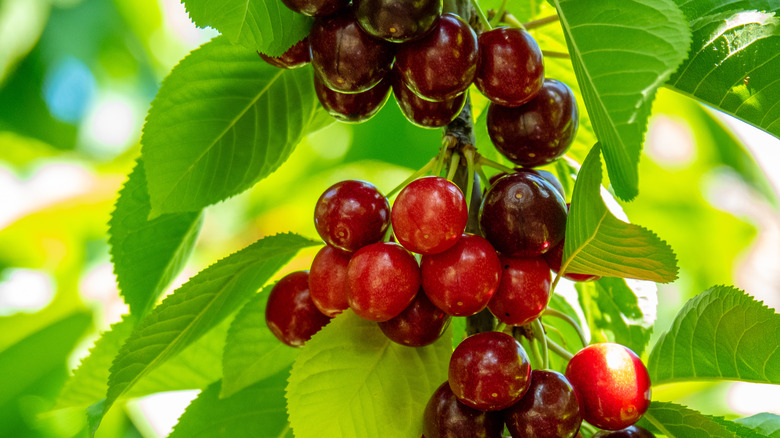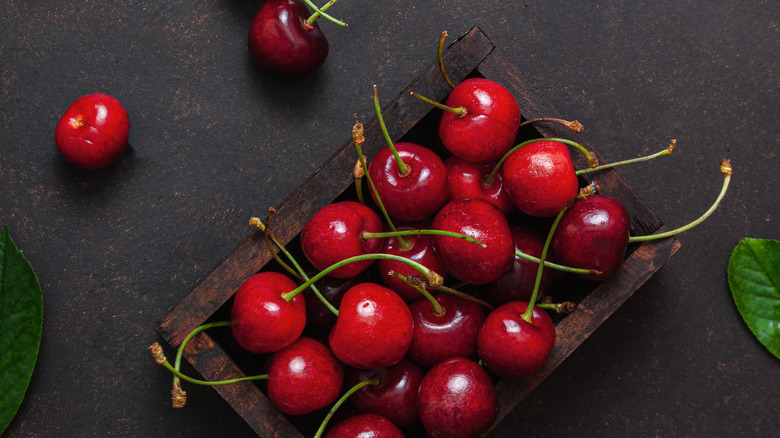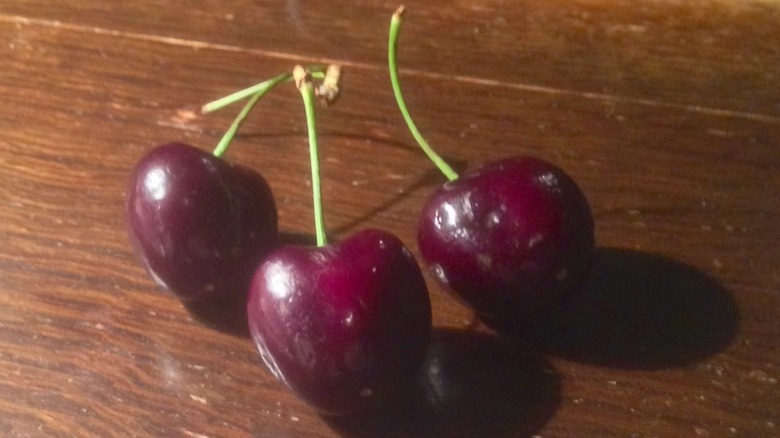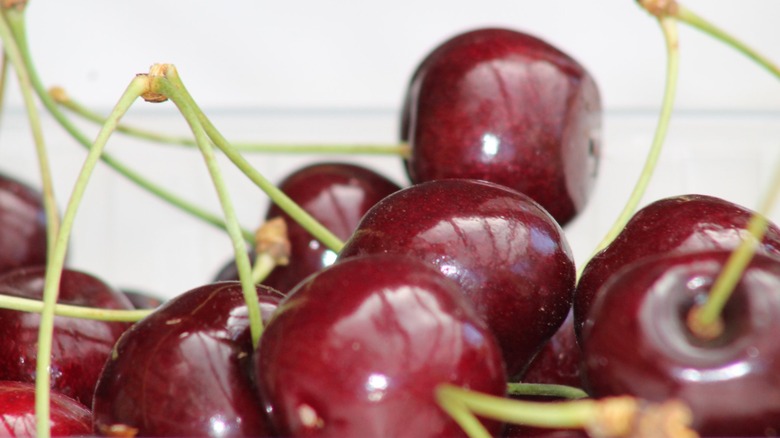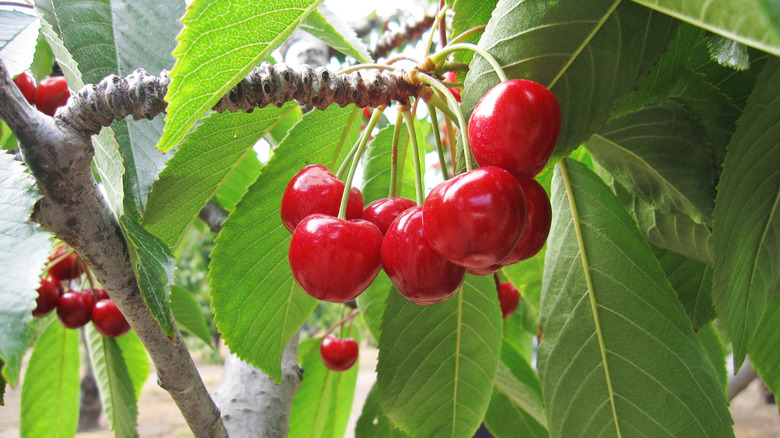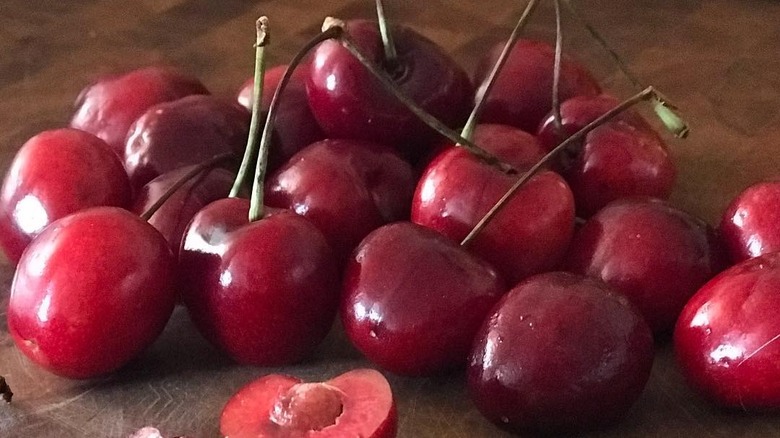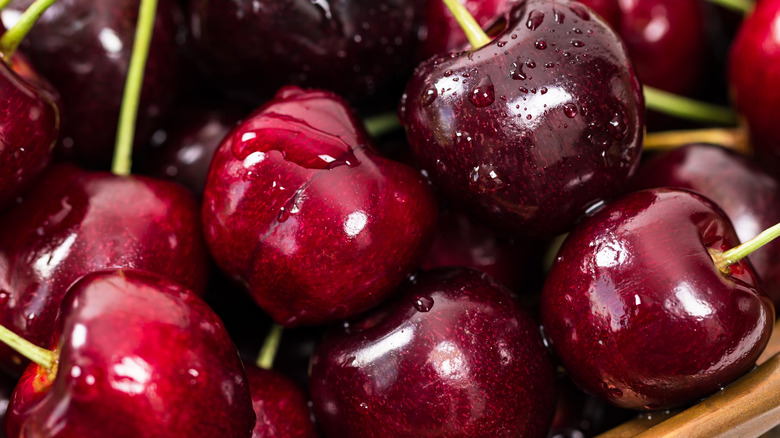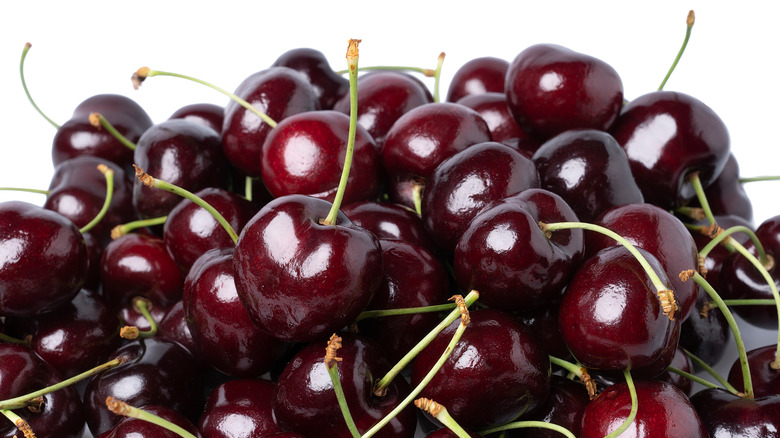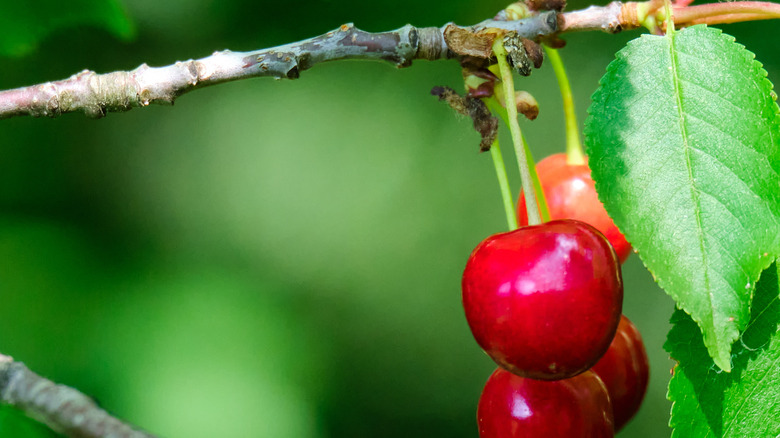29 Types Of Cherries And What Makes Them Unique
We're no strangers to cherries. From decadent cherry pies to rich, indulgent black forest gateau cheesecakes and black cherry ice creams, they all have one thing in common — the star ingredient "cherry." Needless to say that these quirky pocket-rockets of fruit are deeply embedded within global cuisine. Besides being insanely delicious and easy on the eyes, cherries are chock-full of incredible health benefits. According to Healthline, cherries are loaded with antioxidants and a potent blend of essential nutrients. MedicalNewsToday goes one step further and notes that the anti-inflammatory action of cherries can work wonders for easing joint pain associated with gout.
There are literally dozens and dozens of cherry varieties, some of which you have likely encountered in the produce section and some you may not have seen or even heard of. Whether you want to kick off your health journey or are simply bored with your same-old local cherry varieties and feel like experimenting, here is a tour of 30 types of cherries from all corners of the globe. We'll also cover the various ways you can use each type for an absolutely delicious and satisfying bite.
1. Dark red cherry
The OG of cherries, dark red cherries, are a universally popular and well-loved cherry variety that originated in Turkey but was brought to other parts of the world with time. These dark red or mahogany-colored cherries are typically available at the end of August (via Sage Fruit). On the outside, the delicate dark red cherry is round to oval with a melt-in-your-mouth vibrant red flesh inside. Filling your mouth with sweetness and juiciness with every bite, Stemilt notes that you can use the dark red cherries in just about everything, from eating them raw to using them in a dessert. They are also an excellent addition to your salads.
But the best thing about dark red cherries is that they are super versatile. Jams, sauces, juices, lip gloss, body scrubs, and wine, you name it — there isn't much that dark red cherries can't be used for.
These cherries are also highly nutritious and contain various vitamins and minerals such as potassium, manganese, and copper. With a healthy dose of fiber, dark red cherries can help promote healthy digestion. For folks with sleep troubles, dark red cherries are chock-full of melatonin. Having a light post-dinner cherry snack may improve your sleep quality. And as LiveStrong notes, the antioxidants in dark red cherries can help fight oxidative stress and prevent diseases such as diabetes, cardiovascular issues, and macular degeneration.
2. Tieton cherry
Extraordinarily large, firm, and mildly sweet, the Tieton cherry was first created in Washington State in the late 20th century. Specialty Produce notes that Tieton cherries are relatively large with pronounced curves ending in a narrow base. Their skin is glossy and smooth with a deep mahogany color, which sometimes looks black. Beneath that skin is an aqueous, firm, and crispy flesh that gives off dark purple hues.
They are neither prolific when it comes to production nor self-fertile but can be shipped long distances. Their stem holds moisture for extended periods, making them a suitable export choice in the early fruit season.
According to King Brands, the high potassium reserves in Tieton cherries make them a potent blood sugar level regulator. Best of all, they are loaded with vitamin A which is essential for proper organ functioning, and calcium to help strengthen your bones and teeth (via Medical News Today).
3. Yellow cherry
Cherries aren't just red and black. They're also yellow. Usually, people associate cherries with the color red, but they ignore the sweetest variety, the yellow cherries, also known as Rainier. Cream-yellow colored with a red blush; yellow cherries have a more complex flavor profile than their counterparts. For starters, they have nearly one-third more sugar than other cherry varieties. Currently, there are 10 varieties of yellow cherries in production, as per My Flowers.
Fine dining Lovers note that yellow cherries were developed in the U.S. 60 years ago by Harold Fegel and his peers. They crossed Bing and van cherries and produced an even sweeter, yellow variety.
The skin of Rainier cherries is thinner than other varieties while containing similar nutrients such as potassium, vitamin C, and antioxidants. The list of possible health benefits of yellow cherries seems never-ending, from controlling diabetes to reducing the risk of heart diseases and potent anti-inflammatory action.
On the eating part, you eat them right after plucking. You can also preserve them for later use in the form of jams or freeze the fruits in an airtight plastic bag. They go well with all sorts of desserts, ice cream, pies, cakes, pastries, etc.
4. Bing cherry
Bing cherries are loved for many reasons, from their color to juiciness and sweetness. Maroon to dark red on the outside with a bright red flesh, the pits of these cherries are surrounded by dark red hues (via This Old House).
Bing cherries have a firm, snappy texture, and their pit is inedible. They're amongst the most popular cherry varieties in the United States and are primarily targeted toward fresh markets. In fact, they act as a benchmark for the growth of other varieties in Washington State.
Farmers use its growth to determine the availability of other cherry varieties. Since they are incredibly weather-resistant and can withstand droughts, bing cherries are grown both commercially and in home gardens.
The bing cherries are super nutritious, and just about every part contributes to health and well-being. Specialty Produce states that these cherries contain beneficial nutrients like vitamin A, C, and antioxidants, which can help reduce inflammation and strengthen your immunity. Thanks to their tart flavor, you can use bing cherries in endless ways, from cooking to eating to canning and freezing.
5. Black cherry
It's time to give up your typical red cherries and go for these brilliant black ones the next time you're out cherry shopping. These brilliant black gems originated in North America and currently have two subspecies in Canada, Mexico, the U.S., and Guatemala. Its dark color, juiciness, and unique aroma symbolize the start of the summer.
According to Les Vergers Boiron, black cherries were first brought to Europe by the Greeks and Romans to use in a meat-based diet. With time, it become a universally favorite option for desserts and sweet condiments. Fun Fact: North Americans experienced black cherry for the first time in the 16th century.
They have a bitter-sweet flavor and are often used in making wine and jelly. Besides being insanely delicious, the black also means they are bursting with anthocyanins — an antioxidant that helps boost your brain function, improve sleep, and lower the risk of chronic diseases such as diabetes, heart diseases, and even cancer. What's more, they are also an excellent source of vitamin A, B, and C and contain important trace minerals, such as magnesium, calcium, and potassium (via WebMD).
6. Montmorency cherry
The French have a unique way of making everything better, and the Montmorency cherries are no exception. Montmorency U.S. Tart Cherries notes that these cherries are named after a valley in the Northern suburbs of Paris where they were first cultivated. Today they are usually grown in the U.S. and Canada. Michigan is one of the primary producers of this cherry variety (via Minneopa Orchards).
Smaller than your regular cherries, the tiny oval-shaped Montmorency cherries are a petite cherry variety with a uniquely sour taste. Vibrant red with firm yellow flesh, Montmorency cherries are a relatively unknown and somewhat mysterious cherry variety.
Since fresh Montmorency cherries have a strong tangy element, they go well in jellies and jams. Best of all, you can use them as toppings for your ice cream topping and fold them into your desserts. According to Martha Stewart, aka the "Queen of Domestic Arts',' Montmorency cherries provide several options for your kitchen, such as cooking, freezing, or juicing. Best of all, despite all that, their nutritional value stays intact.
This relatively unknown cherry variety is gradually rising to global prominence. While this is for several reasons, it's mainly because these beautiful cherries are known to be very nutritious. Montmorency cherries are brimming with potassium, fiber, antioxidants, and melatonin. The melatonin in Montmorency cherries will help you sleep better and finally ditch your sleeping pills. Besides that, these cherries also improve your gut health and can be an excellent post-exercise recovery snack (via WebMD).
7. Amarena cherry
Amarena cherries are perhaps the favorite cherry variety of chefs, given their uniquely exquisite taste. While they taste bitter, amarena cherries are usually used in a sweet syrup. Pre Gel notes that this combination of sweet and bitter differentiates amarena cherries from the overly sweet maraschino cherries. What really sets apart the amarena cherries is their extra firm and succulent flesh.
Good news for foodies: amarena cherries can be used in various ways in the kitchen. They are usually used as toppings for ice creams and waffles. However, you can also add them to your desserts, salads, smoothies, pies, cakes, and pastries and enjoy their magical taste (via Lazaya Fruits).
According to Amarena, all health-conscious folks can devour these cherries guilt-free since they are fat-free and contain multiple beneficial nutrients, including vitamin C, fiber, potassium, folate, iron, and magnesium. Fun fact: amarena cherries also have a bigger dose of antioxidants than grapes, oranges, and strawberries.
8. Maraschino cherry
Maraschino cherry is something that's unique among all these different varieties of cherries. Well, for starters, it doesn't grow on a cherry tree. The maraschino cherry is basically the preserved, sweetened form of other light-colored cherries, including Royal Ann and Rainier.
The history of maraschino cherries goes back 200 years to Italy and Yugoslavia. WebMD notes that maraschino cherries were first prepared by merchants who soaked marasca cherries in maraschino liqueur and enjoyed it later. These beauties made their way to the U.S. in the 1890s and were imported for the top hotels and restaurants.
There are primarily two forms of maraschino cherries: alcoholic and non-alcoholic. They come in a whole rainbow of colors, from red to orange, to green and blue. However, natural varieties of maraschino cherries use beet or radish juice and do not contain any artificial color. They are sweet but darker and softer than their synthetic counterparts.
Coupled with a slight hint of almond flavor (from the cherry pita during distillation), maraschino cherries taste more like candies than fruit. Instead of adding any depth or special flavor to a cocktail or dessert, it brings a wave of sweetness. However, maraschino cherries preserved in the original maraschino liqueur stay true to the original cherry flavor (via What's Cooking America).
The sweetness and pretty rainbow colors of maraschino cherries can add a delightful touch to your cocktails. They can also be used as toppings for desserts and ice creams.
9. Lambert cherry
Lambert cherries have been around for a while, 160 years to be exact. They were first cultivated back in 1848 in Oregon. They originated when May Duke and Napoleon cherries were crossbred. Full of mouth-watering juiciness, lambert cherries are sweet and crisp to touch, making them perfect for cooking or eating raw.
Minneopa Orchards notes that lambert cherries are perhaps the best choice for commercial cherry cultivation because they are highly resistant to pests. They do not need perfect conditions to turn out a good crop. They are also self-fertile, meaning they do not need cross-pollination to grow.
Lambert cherries usually find themselves in pastries and pies but also work for crisps, bread, and glaze. Additionally, lambert cherries are perfect for preserving in the form of jellies and jams. Stemlit suggests freezing them in a plastic bag and using them as toppings for homemade ice creams.
10. Chelan cherry
These mahogany red and heart-shaped cherries are a bing cherry look-alike. They were first created by a researcher at Washington State University and have been a part of the Washington cherry scene ever since.
Take Seeds notes that chelan ripens much more quickly than Bing, so you can expect them to come out mid-May from California and late June from Washington. Due to a twin dwarf infection in the 1990s, the modern implantation of chelan cherries is done on accredited timber.
While they are sweet, containing 16% to 18% sugar, it's not as much as bing cherries. If you don't have a sweet tooth, chelan cherries are your best option. Folks with blood sugar problems should still eat them with caution, though, as the sugar inside them is still high. Besides the relatively low sugar content, chelan cherries are loaded with vitamin C and antioxidants (via Antioxidant-fruits.com).
11. Meteor cherry
The meteor cherries are an American delight growing there for the last 100 years. A hybrid cherry that has its origins with the Russian variety and Montmorency cherries, meteor cherries were first developed and cultivated at the University of Minnesota (via My Garden Life).
These gorgeous dark red beauties with a yellow flesh and a tangy flavor are nutritious food sources for humans and wildlife alike. The meteor cherry trees are pretty resistant to cold temperatures and diseases (via Montana Fruit Tree Company).
Minneopa Orchards note that some varieties of meteor cherry are much more tart and tangy than their sweet counterparts, making them perfect for cherry pies. The best part about meteor cherries is that they keep their shape and taste intact even after cooking, steaming, or canning. These cherries are also an excellent juicing option, and are ideal for throwing in the freezer for later use.
12. Utah giant cherry
Utah Giant cherries, despite the name, have no relation, appearance, or connection to giants. However, they are considered among the best sweet cherries, at least by the folks of Utah.
As per Minneopa Orchards, Utah giant cherries were first created in Logan, Utah, back in 1981. These mighty cherries are incredibly versatile. Since they are freestones, the flesh is not attached to the stone and does not need to be cut to free it. You can eat them right off the tree or preserve them for later use. In a 2014 DWN Fruit Tasting Report, the Utah giant cherry was rated as the best-tasting cherry (via Dave Wilson Nursery).
Sweeter than most cherry varieties, you can use them in sauces or your desserts to add a pop of color. What's interesting about Utah giant cherries is that they maintain their bright red color and flavor even during processing (via Gurneys). Best of all: The anti-aging credentials of Utah giant cherries are incredibly strong, thanks to the antioxidants inside them.
13. Tulare cherry
Tulare cherries get their name from the great Tulare County, where they originally come from. Tulare cherries were first discovered in 1974 in Le Grand, California, which became a heaven for them, thanks to its ideal climate. The California climate allows cherry cultivators to bring their produce to the market in April, which is much earlier than the cherries coming from the Pacific Northwest (via Gardening Know How).
As for the shape of Tulare cherries, it lies somewhere between oblong and round. Specialty Produce keenly observes that the skin of these cherries is relatively thin, and its color ranges from bright red to dark red. The flesh under the skin is aqueous and firm, brimming with fibers and juice. They have a strong aroma with an acidic nature, giving them a tart and sweet taste.
Thanks to their deliciousness and unique texture, Tulare cherries can be used in multiple ways. When it comes to cooking, they can pair up perfectly with vanilla, cinnamon, almonds, hazelnuts, and cream. Tulare cherries lend themselves well to preservation, too, through freezing, canning, and drying.
Put them in an oven to dry, in a sugar syrup to can, and in a freezer bag to freeze –- the options are abundant (via Minneopa Orchards).
14. Van cherry
Another member of the cherry family is the van cherry. This delightful cherry is another British Columbian treat and one that Specialty Produce notes was first introduced by A.J. Mann in Okanagan Valley, British Columbia, by open pollination of empress Eugenie cherry in 1936. With the approval for commercial cultivation in 1942, they soon reached Australia, Germany, and the United States.
These crimson to dark red round fruits, technically known as "drupes," have a smooth and taut skin with deep purple undertones. The red flesh inside is aqueous and tender, with an inedelible pit in the center, which should be discarded before eating or processing.
As per Gardening Know How, van cherries have a sweet and tart taste, making them perfect for both savory and sweet dishes. You can consume them raw after discarding the pit or use them in your desserts and ice creams. You can also mix them in your fruit salads, salsas, and smoothies.
If you don't want to consume them raw, you can preserve them as jams and jellies. The uses do not end here, though. Van cherries can also be baked into loaves of bread and muffins. A special use for van cherries is making barbeque sauce out of them, which can be used over smoked dishes (via Specialty Produce).
15. Lapins cherry
Large, sweet, and crisp, these mahogany red fruits were first developed in British Columbia by Dr. Lapin at the Pacific Agri-Food Research Center. Gardening Know How notes that they are popular among home and commercial growers, thanks to their ability to self-pollinate.
According to Specialty Produce, lapins cherries are best eaten straight raw, though, of course, after washing it off and perhaps removing some of its excess water. When it comes to making cocktails, lemonade, and fruit beverages, lapins cherries are the best choice. That said, you don't necessarily have to eat them raw. Lapins cherries are equally delicious when used as fillings in cakes and muffins; they pair well with different types of meat, such as pork and poultry, and almonds, pine nuts, and hazelnuts.
Lapins cherries aren't only versatile; they are also a supremely healthy addition to your diet. As noted by Specialty Produce, the potassium in lapins cherries help maintain your electrolyte balance, and the calcium strengthens your bones and teeth.
Moreover, they are loaded with vitamin A & C, resulting in better skin and a more robust immune system. And since we can all do with a little extra immunity these days(read: corona), it's time to amp up your lapins cherries intake (via WebMD).
16. Sylvia cherry
Perhaps the most delightful name on this list, sylvia cherries are a cross between van and sam cherries and were first introduced in 1957 in Canada. These dark red fruits are compact and filled with sweet juice but, unlike most cherry varieties, don't have any overpowering sugariness. Round-shaped with a dark-red skin and firm texture, sylvia cherries are perfect for both using raw and making jams (via Excelentes Precios).
According to Garden Focused, sylvia cherries regularly produce a large quantity, thanks to their resistance to disease and infections. Sylvia cherries are self-fertile, but pollination with a suitable partner can produce a better crop. They go well with several pollination partners such as van, stella, sunburst, and morello cherries.
Sylvia cherries are pretty picky, though: These fruits require certain conditions to grow, such as a place where they get full sun. Since they are compact, you can even grow them in pots and containers. Usually, a heavy pot of 20 inches is enough for it to stand its ground firmly. And the good news, as noted by GardenLux, is that growing them does not require much effort, as the sylvia cherry tree is incredibly resistant to harsh atmospheric conditions and infections.
17. Benton cherry
The benton cherries carry many hats: These dark, heart-shaped fruits with a semi-freestone are moderately sweet and have a radiant glow, as per Minneopa Orchards. Benton cherries are basically a cross between beaulieu and stella cherries, first introduced at Washington State University Prosser Research Center.
Interestingly, the popularity of benton cherries does not come from their flavor or taste but from their disease resistance and high low maintenance. They have a subtle sweetness that is not overpowering and less pronounced than other varieties (via Gardening Know How).
Fortunately, they do not need a lot of water for growth, and an area with suitable rainfall is enough for them. The striking benton cherry tree with white blossoms does not even need fertilizers until the tree starts producing fruit. Thanks to their long life in the freezer, benton cherries are an excellent choice for exports.
These multipurpose fruits can be eaten raw, cooked, frozen, or dried in an air fryer for later use. They go equally well with both hot and cold dishes such as smoked meat, cheese, ice creams, cakes, pastries, etc.
18. Black Republican cherry
Named after the black members of the Republican party who were against slavery, these cherries were first introduced by abolitionist Seth Lewelling. As per Trees of Antiquity, black Republican cherries are round to oval with a curve at the end of the stem. Their skin is smooth and glossy, often dark red and sometimes black. Inside a red, succulent, and firm flesh lies a freestone pit.
Given their intense taste, black Republican cherries can be used both raw and cooked. When used in green salads, fruit salads, or salsas, these cherries pair up well with all of them. Squeeze them into juices, blend them into smoothies, mix them up in oatmeal or whip a black cherry ice cream; the possibilities are literally endless with this fruit (via Specialty Produce).
The black Republican Cherry has a truly versatile flavor with a mixture of sweet, earthy, and tart notes. Some people also sense roses, almonds, and herbs after eating them. You'll be glad to know that black Republican cherry's flavor does not fade off even after cooking. A word of caution, though: the deep purple juice can stain your fingers and clothes (via Minneopa Orchards).
19. Royal Ann cherry
Keeping true to its gorgeous name, the royal Ann cherry has often been associated with different names from the royalty. It has also been called Queen Ann and Wellington, Napoleon Bigarreau, and Oxheart in England over the centuries. The earliest mentions of royal Ann cherries date back to 1667 (via Good Fruit Grower).
According to Minneopa Orchards, royal Ann cherries offer a beautiful blend of red and yellow that makes for quite a stunning sight. The taste is as incredible as the fruit's looks, bringing a bout of sweetness through its yellow flesh, which is hard to beat. Canning is the way to go if you are buying in bulk but cannot consume them right away. They are also the best choice when making maraschino cherries because of their intense sweetness. Since they are so incredibly delicious, birds have a keen eye on them. So, cover any growing cherries in your garden with netting for proper protection.
20. Stella cherry
Stella cherry is another work of art. As per This Old House, they have a smaller tree size. This means that they are a suitable option for growing in your backyard. For those unfamiliar, these dark red and juicy cherries can withstand cracking and splitting really well. They are also self-fertile, meaning planting them only once results in years of delicious harvest.
These fruits are filled with sweetness and can be consumed right after plucking them from the tree. Most trees do not produce any fruit in the first year, but the Stella cherry tree does.
However, eating them raw right off the tree isn't the only way you can use Stella cherries. Large production means consuming them all in-season isn't possible. The best way to enjoy them all year round is through canning and jams. You can also freeze them in airtight containers for ice creams, smoothies, and other desserts (via Minneopa Orchards).
21. Sweetheart cherry
Now, that's a name! Sweetheart cherries were first introduced by the Summerland Research and Development Center on Summerland RDC back in the 1990s. They are prized for their heart-like shape and succulent texture. The taut, thin, glossy skin houses dense, bright red flesh with a super-sweet and mildly tart flavor (via Specialty Produce).
Minneopa Orchards notes that the sweetheart cherries have a distinct sweet taste with elements of tanginess and acidity, creating a perfect blend of sweet and sour. They are typically available mid to late summer and are exported worldwide.
As per The Grove, there's more to sweetheart cherries than just their pretty aesthetics and taste. They are loaded with anthocyanins, which give them their distinctive dark red and purple colors. However, these pigments are not just for coloring; they are also excellent antioxidants that protect your cells from free radical damage. Besides that, sweetheart cherries are also packed with Vitamin C, A, potassium, calcium, and iron (via Healthline).
You can use these versatile cherries in various delicacies, including pies, cakes, pastries, doughnuts, etc. Similarly, you can also add them to your desserts, salads, and fruit bowls. For those who want to use them off-season, canning, freezing, and drying are the best choices (via Davita).
22. Skeena cherry
Minneopa Orchards theorizes that skeena cherries originated in British Columbia, where van and Stella cherries were crossed with bing and Stella varieties. Originally released commercially in 2000, these dark red cherries are highly resistant to environmental factors such as frost and rain (via Tsesmelis Fruit & Nut Nursery).
Skeena cherries are incredibly versatile and can be eaten in several ways, but as noted by Minneopa Orchards, skeena cheesecake is an excellent way of using these cherries. You can eat them raw, cook them, or store them for the whole year. If you want to really shake things up, use skeena cherries in tarts, pastries, smoothies, and homemade ice creams.
Moreover, you can also use them to top your waffles and fritters or blend in with your favorite smoothie. Whatever you choose to do with skeena cherries, you will enjoy them equally as they do not lose their taste. As Minneopa Orchards notes, skeena cherries are loaded with manganese, copper, vitamin C, and antioxidants. With excellent anti-inflammatory properties (courtesy of the antioxidants), skeena cherries can do wonders for folks suffering from arthritis, heart disease, and cancer (via Medical News Today).
23. Santina cherry
Santina cherries are a Canadian creation. They are a cross between summit and santella cherries and were first introduced in 1973 by the Pacific Ari-Food Research Station in British Columbia. These reddish-black and heart-shaped cherries have a dark red flesh that is sweetest when ripe. Santina cherries have a unique depth to their flavor, a subtle tartness that offsets its sweetness perfectly (via Gardening Know How).
As per Excelente Precio, santina cherries are self-fertile fruits. However, they are typically a bit more plump and abundant if there is another cherry in the vicinity. Their water requirement is not drastic either, as they can rely on rainfalls alone. However, unlike other cherry varieties such as the bing cherry, they aren't as resistant to rain and crack easily amidst heavy rains.
Usually, santina trees are mulched to preserve moisture, which also prevents cracking. Interestingly, the santina tree does not require any fertilizer until it starts bearing fruit. Like other cherries, you can eat santina cherries fresh or store them via freezing or drying to use whenever you desire.
24. Regina cherry
Regina cherries are a fantastic catch, or rather, a fantastic find. Although they originated in the 1950s in Germany, these cherries were first introduced commercially in 1998. They are a cross-breed of Rube and Schneiders Spate varieties (via Minneopa Orchards).
Minneopa Orchards notes that the flavor of these fruits changes as they approach ripeness. If you taste them when they are not fully ripe with red skin, they are sweet with a tangy element. However, fully ripe regina cherries are dark purple and much sweeter.
They are an excellent option for baking, as you can use them both fresh and dried. Muffins and pies freeze well, too, so you can make lots of them during the regina cherry harvest season, which is typically late June, and freeze them for later use. Raw cherries are equally delicious, and you can blend and mix them in yogurt, smoothies, oatmeal, ice creams, and cereals. As per Savory Experiments, you can also use regina cherries in several jam or jelly recipes.
25. Emperor Francis cherry
Another royalty-inspired cherry variety on our list, Emperor Francis cherries, traces the fruit's origin to the early 1900s in the United Kingdom. Over time, it gained worldwide popularity. These cherries are delightful and crisp, so much so that people often call them "nature's candy."
With so much sweetness packed inside Emperor Francis cherries, they are the perfect candidate for making maraschino cherries. They are also used in baking cookies, pastries, and pies (via Gardening Know How). If baking isn't your thing, the Emperor cherries are also great for making syrups, glazes, and sauces to drizzle on your meat dishes. Raw cherries are equally delicious and can be added to smoothies, yogurt, etc.
Full of fibers, these fruits are incredibly healthy for the gut. They are jam-packed with vitamin C and potassium, which help boost your immune system and regulate blood pressure. With their potent anti-inflammatory properties, Emperor Francis cherries could potentially help you cope with stress and reduce the risk of stress-related diseases like IBS and depression (via Minneopa Orchards).
26. Coral Champagne Cherry
The prettiest variety on our list, the origins of the coral champagne cherries are not exactly known. However, there is speculation that they might have resulted from cross-breeding between at least two varieties of cherries. Bright pink on the outside and dark pink on the inside, coral champagne cherries are exceptionally sweet with low acidity levels (via Gardening Know How).
Momobud notes they are the third most popular cherry variety to come out of California, thanks to their incredible taste and appearance. They ripen faster than some other cherry varieties, such as Bing. Their sweetness makes them ideal for use in breads and pies. Apart from baking, you can also make sauces out of coral champagne cherries to use with meats such as pork, chicken, beef, etc.
SFgate mentions that coral champagne cherries require a location with full sunlight and temperatures between 32 to 45 degrees Fahrenheit. With that, they also need ample amounts of water to produce a decent harvest.
27. Black tartarian Cherry
Oldies but goodies, black tartarian cherries are amongst the oldest cherry varieties dating back to England in the 1700s. These cherries are famous amongst home growers because of their abundant growth and beautiful flowers. They are also pretty tough. black tartarian cherries can tolerate almost all types of soils and withstand droughts, too (via Gardening Know How).
As noted by Specialty Produce, black tartarian cherries are amongst the most delicious sweet cherries available today. They have a rich, concentrated flavor and contain lots of juice for mouth-watering bites.
Previously known as "Ronald's Large Black Heart." — not inspired by an actual human heart, though. These fruits can take center stage in whatever dish they are included in. Be it traditional or modern dishes, black tartarian cherries can seamlessly blend in with anything. Best of all, their juices can make your meat dishes even more scrumptious (via Minneopa Orchards).
If you want to eat them all raw, be our guest. These large, purplish-black fruits will fill your mouth with a sweet, rich, full-bodied flavor. Simply take the pits out and enjoy them raw or blended in your favorite smoothie recipe. And that's not all. You can also freeze, can, or dry black tartarian cherries and enjoy them later (via Simply Canning).
28. Kordia cherry
Another interestingly-named cherry variety, kordia cherries, produces the "blackest" color of all cherries. They hail from Czechoslovakia and the fruits are dark red to black on the outside and bright red on the inside (via Frank P Matthews).
Rather large in size, usually 28mm, kordia cherries have a balanced combination of sweetness and just the right acidity levels. According to Excelentes Precios, the fruits are firm, making them an excellent option for long-term cold storage. Their disease resistance is also commendable, which helps them deal with problems such as cankering and splitting. However, they are sensitive to frosts, and a sharp temperature fall can harm them.
Garden Focused goes one step further and notes that kordia cherries are not self-sufficient in terms of pollination, so they need other varieties to reproduce. The most suitable options in this regard are Stella, Morello, sunburst, and penny. Like other cherries, they are also prone to bird damage and must be covered by nets. Cherry blackflies, aphids, and winter months are the most damaging pests for kordia Cherries (via RHS).
29. North star cherry
North Star cherries, not inspired by the actual North Star, were developed by the University of Minnesota. They come under the dwarf category, meaning the north star cherry tree has a small footprint. Don't let the fruit's small size put you off, though. These cherries start tangy and tart, but it only lasts for a short while before transitioning into full-bodied sweetness.
When it comes to using north star cherries in your food, the world is your oyster. From jams to desserts to pies and marmalades, they won't disappoint. If you aren't a fan of eating tart cherries, you can simply bake them in your favorite desserts.
As per Your Garden Sanctuary, nothing can beat a fresh north star cherry snack during the summers. A perfect alternative to harmful sugar-loaded candies, just pluck north star cherries from the tree and enjoy the goodness in its purest form. You can also store them for later through freezing, canning, and drying.
